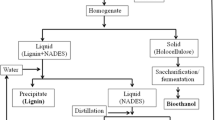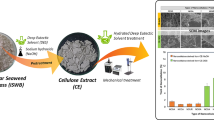Abstract
A new cellulose solvent ionic liquid 1-butyl-3-methylimidazolium chloride ([BMIM]Cl) was used to treat wheat straw and steam-exploded wheat straw (SEWS) in order to improve the enzymatic hydrolysis rates, while the water was used as the control. The enzymatic hydrolysis results showed that the hydrolysis rates of materials treated with [BMIM]Cl were improved. The hydrolysis rate of treated wheat straw could reach 70.37% and the SEWS could be completely hydrolyzed, while hydrolysis rates of the wheat straw and SEWS treated with water were 42.78% and 68.78% under the same conditions, respectively. The FTIR analysis and polymerization degree measurement indicated that the hydrolysis rates improvement was attributed to the decrease of the polymerization degrees of cellulose and hemicellulose, the absolute crystallinity degree of cellulose and the increase of its reaction accessibility.
Similar content being viewed by others

References
Gharpuray M M, Lee Y-H, Fan L T. Structural modification of lignocelluloseics by pretreatments to enhance enzymatic hydrolysis. Biotechnol Bioeng, 1983, 25: 157
Sinitsyn A P, Gusakov A V, Vlasenko E Y. Effect of structural and physico-chemical features of cellulosic substrates on the efficiency of enzymatic hydrolysis. App Biochem Biotechnol, 1991, 30: 43–59
Montané D, Farriol X, Salvadó J. Fractionation of wheat straw by steam-explosion pretreatment and alkali delignification. Cellulose pulp and byproducts from hemicellulose and lignin. J Wood Chem Technol, 1998, 18: 171–191
Montané D, Farriol X, Salvadó J, et al. Application of steam explosion to the fractionation and rapid vapor-phase alkaline pulping of wheat straw. Biomass Bioenergy, 1998, 14: 261–276
Ballesteros I, Oliva J M, Negro M J, et al. Enzymic hydrolysis of steam exploded herbaceous agricultural waste (Brassica carinata) at different particule sizes. Proc Biochem, 2002, 38: 187–192.
Kleinert T N. Organosolv pulping with aqueous alcohol. Tappi, 1974, 57: 99–102
Gilarranz M A, Rodriguez F, Santos A, et al. Kinetics of Eucalyptus globules delignification in a methanol-water medium. Ind Eng Chem Res, 1999, 38: 3324–3332
Swatloski R P, Spear S K, Holbrey J D, et al. Dissolution of cellulose with ionic liquids. J AM Chem Soc, 2002, 124: 4974–4975
Wasserscheid P, Keim W. Ionic liquids — new ’solutions’ for transition metal catalysis. Angew Chem Int Ed Eng. 2000, 39: 3773–3789
Welton T. Room-temperature ionic liquids. Solvents for synthesis and catalysis. Chem Rev, 1999, 99: 2071–2083
Seddon K R. Ionic liquids for clean technology. J Chem Technol Biotechnol, 1997, 68: 351–356
Eckstein M, Wasserscheid P, Kragl U. Enhanced enantioselectivity of lipase from Pseudomonas sp. at high temperatures and fixed water activity in the ionic liquid 1-butyl-3-methylimidazolium bis[(trifluoromethyl)sulfonyl]amide. Biotechnol Lett, 2002, 24: 763–767
Turner M B, Spear S K, Huddleston J G, et al. Ionic liquid salt-induced inactivation and unfolding of cellulase from Trichoderma reesei. Green Chem, 2003, 5: 443–447
Huddleston J G, Visser A E, Reichert W M, et al. Characterization and comparison of hydrophilic and hydrophobic room temperature ionic liquids incorporating the imidazolium cation. Green Chem, 2001, 3: 156–164
Goering H K, Van Soest P J. Forage fibre analysis. Apparatus, reagents, procedure and some applications. Agric Handbook 379. Washington DC: ARS. USDA, 1970. 1–20
Delong E A. Method of rendering lignin separable from cellulose and hemicellulose in lignocellulosic material and the product so produced. Can Pat, 1981, 1096374
Miller G L. Use of Dynitrosalicylic acid reagent for determination of reducing sugar. Analytical Chem, 1959, 31: 426–428
Jiang F C, Shao K. The determination of polymerization degree of Ramie cellulose. GB5888-86, UDC677.151.014/.016, 1986
Focher B, Marzetti A, Beltrame P L, et al. Steam exploded biomass for the prepraration of conventional and advanced biopolymer based materials. Biomass and Bioenergy, 1998, 14(3): 187–194
Chen H Z, Liu L Y, Yang X X, et al. New process of maize stalk amination treatment by steam explosion. Biomass and Bioenergy. 2005, 28: 411–417
Wong K K Y, Deverell K Y, Keith L M, et al. The relationship between fiber porosity and cellulose digestibility in steam-exploded Pinus radiate. Biotech Bioeng, 1988, 31: 447
Ye S, Jiayang C. Hydrolysis of lignocellulosic materials for ethanol production: a review. Bioresource Technology, 2002, 83: 1–11
Clark T A, Mackie K L. Steam explosion as a pretreatment for biomass conversion. J Wood Chem Technol, 1987, 7(3): 373–405
Zhbankov R G., Firsov S P, Korolik E V, et al. Vibrational spectra and the structure of medical biopolymers. J Molecular Structure, 2000, 555(1): 85–96
Langkil de F W, Svantesson A. Identification of celluloses with Fourier-transform (FT) mid-infrared, FT-Raman and near-infrared spectrometry. J Pharmaceutical and Biomedical Analysis, 1995, 13: 409–414
Nelson M L, O’Connor R T. Relation of certain infrared bands to cellulose crystallinity and crystal lattice type. Part I Spectra of lattice types I, II, III and amorphous cellulose. J Appl Polym Sci, 1964, 8: 1311–1324
Nelson M L, O’Connor R T. Relation of certain infrared bands to cellulose crystallinity and crystal lattice type. Part II. A new infrared ratio for estimation of crystallinity in cellulose I and II. J Appl Polym Sci, 1964, 8: 1325–1341
Chen Y R, Xia L M, Cen P L. Pretreatment of corncob by steam explosion process. J Chem Engin Chinese Univ, 1999, 13 (3): 234–239
Ren Q, Wu J, Zhang J, et al. Synthesis of 1-allyl,3-methylimidazolium-based room-temperature ionic liquid and preliminary study of its dissolving cellulose. Acta Polymerica Sinica, 2003, 3: 448–451
Focher B, Marzetti A, Crescenzi V. Steam Explosion Techniques, Fundamentals and Industrial Applications. Philadelphia: Gordon and Breach Publishers, 1991
Kim K H, Hong J. Supercritical CO2 pretreatment of lignocellulose enhances enzymatic cellulose hydrolysis. Biore Technol, 2000, 77: 139–144
Author information
Authors and Affiliations
About this article
Cite this article
Liu, L., Chen, H. Enzymatic hydrolysis of cellulose materials treated with ionic liquid [BMIM] Cl. CHINESE SCI BULL 51, 2432–2436 (2006). https://doi.org/10.1007/s11434-006-2134-9
Received:
Accepted:
Issue Date:
DOI: https://doi.org/10.1007/s11434-006-2134-9



